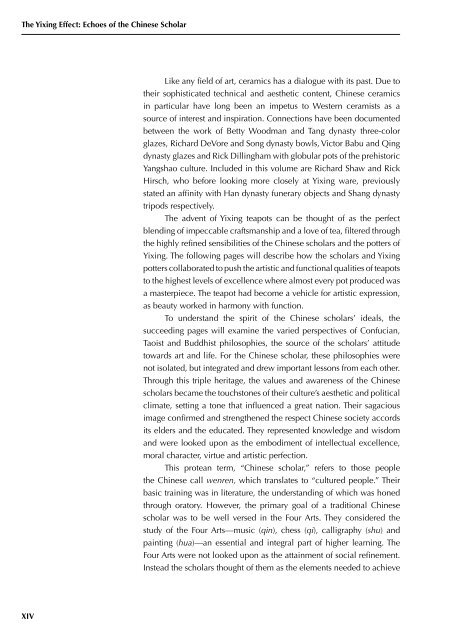THE YIXING EFFECT - Marvin Sweet
THE YIXING EFFECT - Marvin Sweet
THE YIXING EFFECT - Marvin Sweet
You also want an ePaper? Increase the reach of your titles
YUMPU automatically turns print PDFs into web optimized ePapers that Google loves.
The Yixing Effect: Echoes of the Chinese Scholar<br />
XIV<br />
Like any field of art, ceramics has a dialogue with its past. Due to<br />
their sophisticated technical and aesthetic content, Chinese ceramics<br />
in particular have long been an impetus to Western ceramists as a<br />
source of interest and inspiration. Connections have been documented<br />
between the work of Betty Woodman and Tang dynasty three-color<br />
glazes, Richard DeVore and Song dynasty bowls, Victor Babu and Qing<br />
dynasty glazes and Rick Dillingham with globular pots of the prehistoric<br />
Yangshao culture. Included in this volume are Richard Shaw and Rick<br />
Hirsch, who before looking more closely at Yixing ware, previously<br />
stated an affinity with Han dynasty funerary objects and Shang dynasty<br />
tripods respectively.<br />
The advent of Yixing teapots can be thought of as the perfect<br />
blending of impeccable craftsmanship and a love of tea, filtered through<br />
the highly refined sensibilities of the Chinese scholars and the potters of<br />
Yixing. The following pages will describe how the scholars and Yixing<br />
potters collaborated to push the artistic and functional qualities of teapots<br />
to the highest levels of excellence where almost every pot produced was<br />
a masterpiece. The teapot had become a vehicle for artistic expression,<br />
as beauty worked in harmony with function.<br />
To understand the spirit of the Chinese scholars’ ideals, the<br />
succeeding pages will examine the varied perspectives of Confucian,<br />
Taoist and Buddhist philosophies, the source of the scholars’ attitude<br />
towards art and life. For the Chinese scholar, these philosophies were<br />
not isolated, but integrated and drew important lessons from each other.<br />
Through this triple heritage, the values and awareness of the Chinese<br />
scholars became the touchstones of their culture’s aesthetic and political<br />
climate, setting a tone that influenced a great nation. Their sagacious<br />
image confirmed and strengthened the respect Chinese society accords<br />
its elders and the educated. They represented knowledge and wisdom<br />
and were looked upon as the embodiment of intellectual excellence,<br />
moral character, virtue and artistic perfection.<br />
This protean term, “Chinese scholar,” refers to those people<br />
the Chinese call wenren, which translates to “cultured people.” Their<br />
basic training was in literature, the understanding of which was honed<br />
through oratory. However, the primary goal of a traditional Chinese<br />
scholar was to be well versed in the Four Arts. They considered the<br />
study of the Four Arts—music (qin), chess (qi), calligraphy (shu) and<br />
painting (hua)—an essential and integral part of higher learning. The<br />
Four Arts were not looked upon as the attainment of social refinement.<br />
Instead the scholars thought of them as the elements needed to achieve


